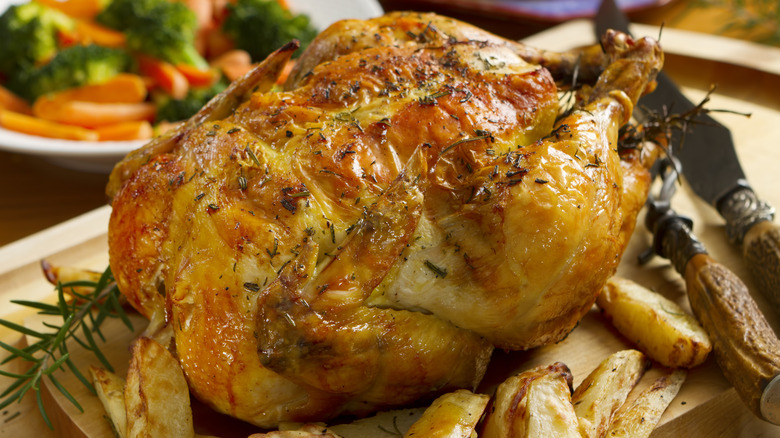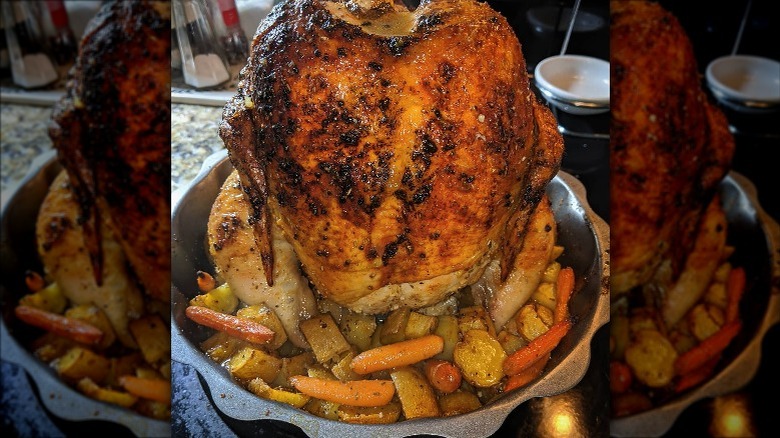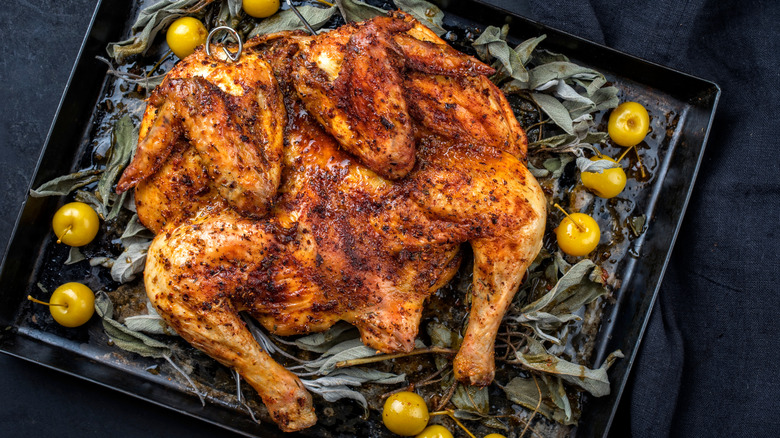The Case For Roasting Your Next Chicken In A Bundt Pan
There are few things as democratic and delicious as roast chicken. This humble meal offers something for everyone— white meat, dark meat, and, the best part, crispy, salty golden brown skin. When properly prepared, there are few dishes as enjoyable, yet this surprisingly simple Sunday afternoon meal can be tricky to perfect.
With unlimited suggestions on how to perfect a roast chicken, we'd like to offer an unconventional option that may be the solution to your common chicken cooking mistakes. Next time instead of grabbing a traditional roasting pan, pull out that rarely-used bundt pan for a winner, winner chicken dinner.
Similar to expensive enameled or cast iron vertical roasting pans and the conversation-provoking barbecue beer can chicken hack, a bundt pan allows you to prop the chicken upright and evenly cook it from all angles without trussing the bird. Thanks to a strategically placed hollow center tube, the chicken simultaneously cooks from the inside and out, delivering juicy meat and audibly crispy skin while cutting down on the cooking time and preventing a soggy bottom.
How to make bundt pan chicken
To make a bundt pan chicken, preheat the oven to 425 degrees and prepare the bird as you normally would, removing the bag of chicken parts from the cavity. Thoroughly dry the chicken inside and out to promote the Maillard reaction since moisture is the enemy of crispy, golden-brown skin. If you have the time, allow the chicken to dry out uncovered in the refrigerator overnight.
Rub the chicken with olive oil or softened butter, then season with kosher salt, freshly ground black pepper, and any herbs you have on hand, including the underside and cavity. The cavity can also be stuffed with cut lemon and a garlic bulb to flavor the meat.
Prepare a 10-cup bundt pan by covering the center tube with aluminum foil to prevent juices from escaping, and place the bundt pan on a rimmed baking sheet to catch any drippings. Although not necessary, cubed potatoes, carrots, and onions can be added to the bottom of the bundt to make a delicious side dish that roasts in the chicken fat as it cooks.
Impale the chicken cavity over the center tube with the legs sitting on the veggies. Then, roast the chicken until a thermometer inserted into the thigh registers 160 degrees, about 15 minutes per pound. Carryover cooking will get the chicken to the United States Department of Agriculture's recommended internal temperature of 165 degrees while the bird rests for 10 minutes before carving.
Spatchcocking a chicken
If you don't have a bundt pan, spatchcocking is another technique that promotes even cooking and browning. The chicken's spine is removed with poultry shears or a chef's knife (save it for stock), and the bird is flattened, splaying the legs and wings by pressing on the breast bone, waiting for a masochistically satisfying crack. Butchers are happy to do this for you, but with the right tools, home cooks can quickly master the spatchcock technique.
Butterflying the bird increases the surface area in contact with the heat, which speeds up the cooking and minimizes the chances of overcooking the less fatty white meat (breasts) while waiting for the dark meat (thighs and legs) to cook. Thoroughly dry and season the chicken as you normally would, but since there's no longer a cavity to fill, save the lemon for after the chicken is roasted.
This is an excellent method for grilling since the entire surface is in contact with the heating element, and the chicken only has to flip once. Still, it can also be roasted in the oven at 425 degrees, besides potatoes, carrots, and onions, for a one-pan meal. Spatchcocked chickens cook faster, so start taking the temperature around 40 minutes.



